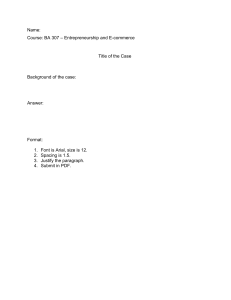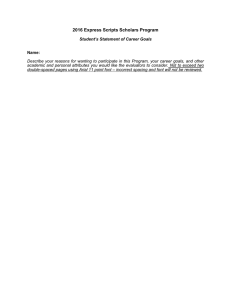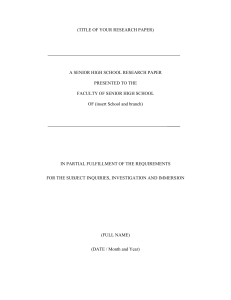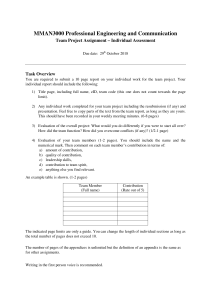Writing Guidelines: Sorsogon State University Engineering
advertisement
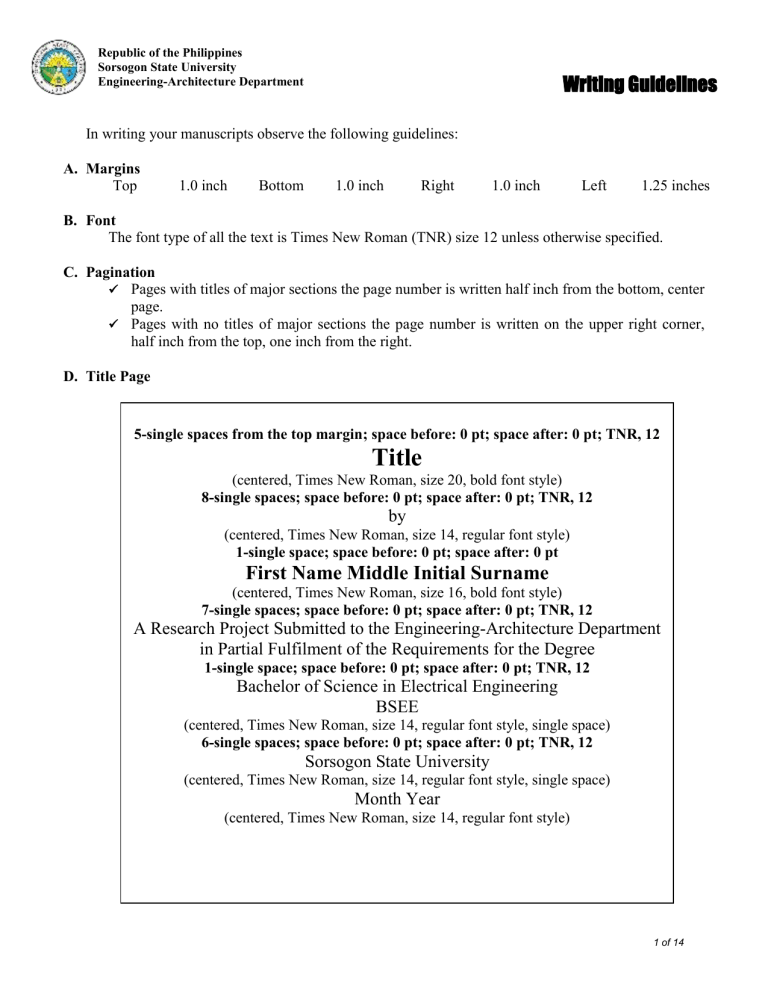
Republic of the Philippines Sorsogon State University Engineering-Architecture Department Writing Guidelines In writing your manuscripts observe the following guidelines: A. Margins Top 1.0 inch Bottom 1.0 inch Right 1.0 inch Left 1.25 inches B. Font The font type of all the text is Times New Roman (TNR) size 12 unless otherwise specified. C. Pagination Pages with titles of major sections the page number is written half inch from the bottom, center page. Pages with no titles of major sections the page number is written on the upper right corner, half inch from the top, one inch from the right. D. Title Page 5-single spaces from the top margin; space before: 0 pt; space after: 0 pt; TNR, 12 Title (centered, Times New Roman, size 20, bold font style) 8-single spaces; space before: 0 pt; space after: 0 pt; TNR, 12 by (centered, Times New Roman, size 14, regular font style) 1-single space; space before: 0 pt; space after: 0 pt First Name Middle Initial Surname (centered, Times New Roman, size 16, bold font style) 7-single spaces; space before: 0 pt; space after: 0 pt; TNR, 12 A Research Project Submitted to the Engineering-Architecture Department in Partial Fulfilment of the Requirements for the Degree 1-single space; space before: 0 pt; space after: 0 pt; TNR, 12 Bachelor of Science in Electrical Engineering BSEE (centered, Times New Roman, size 14, regular font style, single space) 6-single spaces; space before: 0 pt; space after: 0 pt; TNR, 12 Sorsogon State University (centered, Times New Roman, size 14, regular font style, single space) Month Year (centered, Times New Roman, size 14, regular font style) 1 of 14 Republic of the Philippines Sorsogon State University Engineering-Architecture Department Writing Guidelines E. Approval Sheet APPROVAL SHEET (centered, Times New Roman, size 12, bold font style) (Line spacing: double; space before: 0 pt; space after: 0 pt) This is to certify that we have supervised the preparation of and read the practicum paper prepared by First Name Middle Initial Surname entitled Title and that the said paper has been submitted for final examination by the Oral Examination Committee. (justified, single space, Times New Roman, size 12, regular font style except for the name of the student and the title of the study) (Line spacing: 2-double; space before: auto; space after: auto) Firstname M. Last name Adviser (Line spacing: 2-double; space before: auto; space after: auto) As members of the Oral Examination Committee, we certify that we have examined this paper and hereby recommend that it be accepted as fulfillment of the research project requirement for the Degree Bachelor of Science in Electrical Engineering. (Line spacing: double; space before: auto; space after: auto) Firstname M. Last name Panel Member 1 LS: Single; Before: Auto; After: 0 pt LS: Single; Before: 0 pt; After: 0 pt Firstname M. Last name Panel Member 2 LS: Single; Before: Auto; After: Auto LS: Single; Before: Auto; After: Auto Firstname M. Last name Committee Chair LS: Single; Before: Auto; After: 0 pt LS: Single; Before: 0 pt; After: 0 pt (Line spacing: double; space before: auto; space after: auto) This research project paper is hereby approved and accepted by the Engineering-Architecture Department as fulfillment of the research project requirement for the Degree Bachelor of Science in Electrical Engineering. (Line spacing: triple; space before: auto; space after: auto) Rufo D. Durian III, RME Dean, Engineering-Architecture Department (Spacing for this table is the same as above) 2 of 14 Republic of the Philippines Sorsogon State University Engineering-Architecture Department Writing Guidelines Note: For Tables in the approval sheet, only the lines above the names of advisers, panelists, and dean are visible. F. Table of Contents 3 of 14 Republic of the Philippines Sorsogon State University Engineering-Architecture Department Writing Guidelines TABLE OF CONTENTS (centered, Times New Roman, size 12, bold font style) (Line spacing: double; space before: 0 pt; space after: 0 pt) TITLE PAGE i APPROVAL PAGE ii ACKNOWLEDGEMENT iii TABLE OF CONTENTS iv LIST OF TABLES v LIST OF FIGURES vi ABSTRACT vii Chapter 1: THE PROBLEM Introduction Statement of the Problem Significance of the Study Scope and Delimitation Definition of Terms Chapter 2: REVIEW OF RELATED LITERATURE AND STUDIES Related Literature and Studies Gap Bridged by the Study Conceptual Framework Chapter 3: RESEARCH DESIGN AND METHODOLOGY Research Methods Research Design Statistical Treatment of the Study Chapter 4: RESULTS AND DISCUSSION 1 2 3 4 5 6 7 8 9 11 12 13 14 15 16 Chapter 5: SUMMARY OF FINDINGS, CONCLUSION AND RECOMMENDATIONS19 Summary of Findings Conclusion Recommendations REFERENCES 20 22 23 24 4 of 14 Republic of the Philippines Sorsogon State University Engineering-Architecture Department Writing Guidelines APPENDICES 25 CURRICULUM VITAE 26 G. List of Tables, Figures, etc. LIST OF TABLES (Centered, Times New Roman, size 12, bold font style) (Line spacing: double; space before: 0 pt; space after: 0 pt) Table 1.1: Title … Table 1.2: Title … 3 5 Table 2.1: Title … Table 2.2: Title … 8 11 LIST OF FIGURES (Centered, Times New Roman, size 12, bold font style) (Line spacing: double; space before: 0 pt; space after: 0 pt) Figure 1.1: Title … Figure 1.2: Title … 4 6 Figure 2.1: Title … Figure 2.2: Title … 9 10 H. Abstract All capitalized, bold font style, center page alignment Line Spacing: Abstract Body Double Single Spacing before: Auto Spacing before: 0 pt Spacing after Auto Spacing After: 0 pt The abstract gives the reader an overview of the study, based on information from the other sections of the report. The information given in the abstract is usually the basis of many readers as to whether they will read the entire report or not. The abstract is one paragraph of about 100-200 words. The typical information elements included in an abstract are as follows: 1. Some background or general information on the study 2. The main topic (or purpose) of the study and its scope 5 of 14 Republic of the Philippines Sorsogon State University Engineering-Architecture Department Writing Guidelines 3. Some information on how the study was conducted (or the methodology used in the study) 4. The most important findings of the study 5. A statement of conclusion (justified based on the data presented). Space between the body and the word “keyword”: 2-single spaces 0 pt before and after Keywords (maximum of five): first key word, second key word, …, fifth keyword Note: Each key word is separated by a comma I. Body of the Manuscript Chapter 1 (Capitalized the first letter only, bold font style, center page) TITLE (FIRST LEVEL HEADING, bold face, center page) Example: Chapter I THE PROBLEM Line spacing: double space Spacing before: 0 pt Spacing After: 0 pt Paragraph indention: 1.50 cm Alignment: justified. Line spacing between the first level heading and the body: 1-double space; 0 pt before and after Line spacing in the body: double space; 0 pt before and after No extra space will be given after the last sentence and another paragraph Two spaces between period and another sentence Introduction Content of Introduction** The introduction gives an overview of the research report, giving the reader background or basis of the problem to be reported. It can be divided into six parts, as follows: 1. The setting or context or frame of reference This part gives general statement(s) about a field of research to provide the reader with a preview of the problem to be reported. 2. The review of previous research This part continues the contextual setting or frame of reference given in Part 1 by including more statements about the general aspects of the problem already investigated by other researchers. 3. The gap or missing information This part refers to the statement(s) that indicate the need for the study or the need for more investigation. 4. The statement of purpose This part gives very specific statement(s) pertaining to the objective(s) of the study. 5. The statement of value 6 of 14 Republic of the Philippines Sorsogon State University Engineering-Architecture Department Writing Guidelines This part refers to statement(s) that give the significance of carrying out the study. 6. The scope and delimitation This part indicates what the study covers and what it does not or fails to cover. Statement of the Problem This part gives very specific statement(s) pertaining to the objective(s) of the study. Significance of the Study This part refers to statement(s) that give the significance of carrying out the study. Scope and Delimitation This part indicates what the study covers and what it does not or fails to cover. Definition of Terms This part defines terms according to how they are used. It should be alphabetically arranged. Use acronym for uncommon words. lengthy definition should be in appendix For Chapter 2: REVIEW OF RELATED LITERATURE AND STUDIES that may contain subsublevel headings one must follow the following style: Chapter 2 REVIEW OF RELATED LITERATURE AND STUDIES 7 of 14 Republic of the Philippines Sorsogon State University Engineering-Architecture Department Writing Guidelines <Second Level Heading> Only the first letters are capitalized except for articles and prepositions, bold font style, left justified alignment. <Third level heading> Only the first letter of the first word is capitalized, bold font style, left justified alignment. <Fourth Level Heading> Only the first letters are capitalized except for articles and prepositions, regular font style, left justified alignment. <Fifth Level Heading> Only the first letters are capitalized except for articles and prepositions, regular font style, underlined, left justified alignment. Line spacing: First heading Body Next heading Body double space double space double space double space Spacing before: Auto Spacing before: 0 pt Spacing before: 30 pt Spacing before: 0 pt Spacing after Spacing after Spacing after Spacing after Auto 0 pt Auto 0 pt For the body: Only the first sentence of the paragraph is indented by 1.50 cm. The alignment is justified. Two spaces between period and another sentence. No extra space will be given after the last sentence and another paragraph Content of Related Literature and Studies The review of literature and studies is basically an evaluated, organized, and synthesized collection of citations to other studies (NOT a MERE listing of previous studies), which are related or somewhat related to your own specific research problem. It serves three important functions. 1. It continues the process started in the introduction of giving the readers background information needed to understand your study. 2. It assures the readers that you are knowledgeable about the significant research that has been done in your area of investigation. 3. It establishes your study as one link in a chain of research that is developing and enlarging knowledge in your field of research interest. The role of literature review is as follows: 1. It will increase your confidence in your topic as a result of the time, effort, and resources you invested in studying your research problem. 2. It can give you new ideas and approaches that may not have occurred to you. 3. It can inform you about other researchers doing work in your area of studyindividuals whom you may choose to contact for advice or feedback. 8 of 14 Republic of the Philippines Sorsogon State University Engineering-Architecture Department Writing Guidelines 4. It can show you how others have tackled methodological and design issues in studies similar to your own. 5. It can lead you to sources of data that you may not have known existed. 6. It can orient you to measurement tools that other researchers have developed and used effectively. 7. It can reveal methods dealing with problem situations that may be similar to difficulties you are having. 8. It can help you get meaning out of your data or make sense of your findings and, eventually, help you tie your results to the work of previous researchers. Ways to cite references in review of related literature: All references must be stated in the review of literature; no report will be accepted without the proper acknowledgement to the authors referred to in the literature review. The format of reference for nonverbatim statements is as follows: a) Author stated in year that biosorption of cationic … b) Author stated that biosorption of cationic … (year). c) It has been said that biosorption of cationic … (Author, year). NOTE: Internet references should NOT be included. Gap Bridged by the Studies This part identifies the gap of the related studies. It exerts that something remains to be done or learned in an area of research. Conceptual Framework This part presents the researcher’s understanding of how particular variables in his study connects. For Chapter 3: RESEARCH DESIGN AND METHODOLOGY Chapter 3 RESEARCH DESIGN AND METHODOLOGY Research Methods <Second Level Heading> This part explains the type of research (experimental, survey, etc.) Research Design 9 of 14 Republic of the Philippines Sorsogon State University Engineering-Architecture Department Writing Guidelines <Second Level Heading> This section describes the procedural steps used in conducting this major aspect of your study (i.e. research questions). It is useful to readers who want to know how the methodology of your study may have influenced your results. The procedure should be stated in as much detail as possible so that readers who are interested in replicating or extending your study could follow the steps as they read your work. Schematic diagram (properly labeled and numbered) must accompany the text whenever possible. Statistical Treatment of the Study <Second Level Heading> This part includes all statistical treatment of data. For Chapter 4: RESULT AND DISCUSSION This part presents the data collected from the study on this major aspect of your research problem, followed by extensive comments on or interpretation of the findings of the study Chapter 4 RESULTS AND DISCUSSION For Chapter 5: SUMMARY OF FINDINGS, CONCLUSION AND RECCOMENDATIONS Chapter 5 SUMMARY OF FINDINGS, CONCLUSION AND RECCOMMENDATIONS Summary of Findings <Second Level Heading> This section provides clear answer of each research questions. Write first the research questions, then write the findings that would answer it. Conclusion <Second Level Heading> This part gives the overall conclusion of the study, which addresses the objective(s) of your research problem. Here, you step back and take a broad look at your findings and your study as a whole. Recommendations <Second Level Heading> 10 of 14 Republic of the Philippines Sorsogon State University Engineering-Architecture Department Writing Guidelines This part indicates statements that suggest the need for further studieswhat else can be done relevant to your research problem and what other related problems should be addressed? J. Illustrations For Tables label it this way: Table No. Title Label Data Data Label Data Data Table No. bold font style Title Thick line 1.5 pt Thin line Line spacing: Single Space before: 0 pt regular font style 1.0 pt Space after: 0 pt Aborbance For graphs, figures, illustrations: 0.9 0.8 0.7 0.6 0.5 0.4 0.3 0.2 0.1 0 y = 0.205x - 4E-16 0 1 2 3 4 5 Concentration in M Figure No. Title Properties: If label is necessary place it inside the plot area. No fill effects No outer border Inside tick Smooth lines No triangles or diamonds Title at the bottom of the graph 11 of 14 Republic of the Philippines Sorsogon State University Engineering-Architecture Department Writing Guidelines For reactions: H3C + N Nu + N CH3 Pd a OAc Ph Ph (R) Pd0L* Ph Ph Nu Ph Ph b O O a Nu- = H3 CO - CH Nu- b Ph (S) Ph OCH3 Figure No. Title For Equations: Number the equations in this manner: x + y = 12 (1.1) The first number denotes the chapter and the second number denotes the number of equation in that chapter. The equation number must be right justified and must be written in Times New Roman 12 bold font style. For illustrations with sources: The source of the photo or illustration must be given in this manner: Source: Author, Year (must be aligned with the label) For instruments used in the experimentation: Name of the instrument (Model/Brand, Supplier, Place) K. Bibliography For Bibliography one must follow the following guidelines and must be listed in alphabetical order: BIBLIOGRAPHY (FIRST LEVEL HEADING, bold face, center page) <For journals> 12 of 14 Republic of the Philippines Sorsogon State University Engineering-Architecture Department Writing Guidelines Author, A.A., B. B. Author and C. C. Author (year). Full title of article. Name of the journal, Volume number (number), pages. Author, A.A., et al, (year). Full title of article. Name of the journal, Volume number (number), pages. Author, A. A. (year). Full title of article. Name of the journal, Volume number (number), pages. Examples: Caparanga, A. R. (2000). Recycling and recovery of Poly(ethylene terephthalate) from post consumer waste stream, e-merge: the MIT Review, Volume 1 (1), 27-32. Cardiel, G. G., et al, (2000). Preliminary engineering geological-geotechnical and instability risk assessment of slopes at Peace Village, Barangay San Luis, Antipolo, Rizal. Mapua Research Journal, Volume 1 (2), 79-84. Doma, B. Jr. T., J. L. Salvacion and S.T. Yang (2000). Mass transfer and power consumption characteristics in rotating fibrous bed bioreactor for xanthan gum fermentation. Mapua Research Journal, Volume 1 (1), 27-41. <Books> Author, A. A., B. B. Author and C. C. Author (year). Full title of article<optional> Editor, A. A.<optional>. Book Title, edition, Publisher, Place of Publication. Example: Scilling, R. J. and S. L. Harris (2000). Applied Numerical Methods for Engineers, 1st edition, Brooks/Cole, New York. Note: Internet references should NOT be included. L. Appendices The word Appendices is all capitalized, bold font style, center of page, included in the numbering but not numbered. Name each appendix as A, B, C, etc. Write the title of the appendix using Second Level Heading. Example: APPENDIX A (FIRST LEVEL HEADING, bold face, center page) List of Wire Resistance (Second Level Heading, bold face, center page) For appendix having a landscape format place the pagination on the lower right corner. 13 of 14 Republic of the Philippines Sorsogon State University Engineering-Architecture Department Writing Guidelines M. Book Binding The cover page has the following format: TITLE First Name Middle Initial Surname Sorsogon State University Engineering-Architecture Department Sorsogon City Month Year 14 of 14
